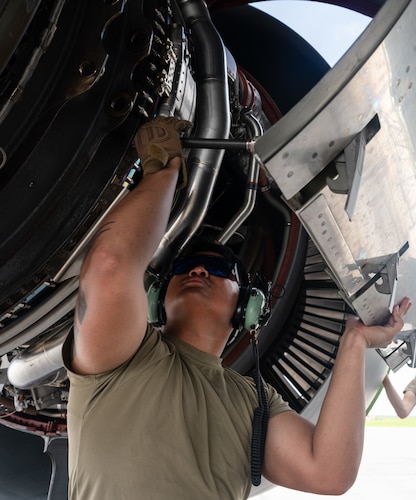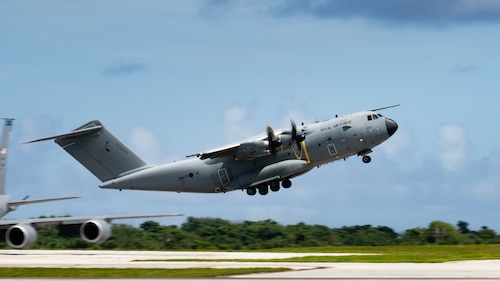Air Mobility Command is executing operations as part of the U.S. Air Force's 2025 Department-Level Exercise series across the Indo-Pacific region to validate its ability to project and sustain combat power, alongside allies and partners, in support of a free and open Indo-Pacific region.
The exercise, which integrates the Air Force Force Generation model and Agile Combat Employment concepts, highlights how the Air Force can deploy within established timelines and support distributed operations in diverse, austere and highly contested environments. Through the AFFORGEN cycle, the Air Force ensures a well-prepared and responsive force capable of supporting various operations across multiple theaters simultaneously.
Following the rapid deployment of aircraft, personnel and mission-essential cargo into theater, and within hours of landing, units established forward operating locations and dispersed aircraft to assorted locations across the Indo-Pacific region. This demonstration of ACE is a key component of the employment phase, which tests how quickly forces can generate missions upon arrival.
"During the employment phase of the DLE series, we anticipated a dynamic operational environment that would challenge our adaptability, coordination and mission command principles-and that's exactly what unfolded," said Lt. Col. Edward Silva, C-17 Mission Generation Force Element commander for the DLE 2025 and 21st Airlift Squadron commander. "Our team seamlessly integrated with the 36th Wing to establish force bed down and actively partnered with our international allies to align on shared objectives."
By putting each Airman's unique experiences and skills to the test during this phase, they were able to overcome challenges in austere environments and execute the mission.
"When communications or command and control systems fail due to distance or other issues, my Airmen executed within the last-given intent and continued to push the mission forward. By the time communications were re-established, the overall mission was further down the track than I had any right to hope. That is culture in action," said Lt. Col. James Vanderneck, C-130 MGFE commander for the DLE 2025 and 41st Airlift Squadron commander.
Another critical component of the employment phase is the U.S. Air Force's ability to leverage the expertise and perspectives of our professionally trained enlisted and officer corps to seamlessly operate as a cohesive unit at a moment's notice.
"The power of this operation came from the cohesion of our people," Silva said. "Many stepped far beyond their comfort zones, tackling unfamiliar tasks with the singular goal of mission success. What we witnessed wasn't just employment-it was empowerment and a clear reminder that when bold operations meet bold teams, the result is remarkable."
This combined knowledge serves as the foundation for successful mission execution by enabling Airmen to move fast, think critically and creatively and disrupt the status quo, finding new concepts of operating in a complex global environment.
"Our crews have been relentless, executing complex airdrops and flying max-endurance missions that span incredible distances," Silva said. "Every flight was a testament to their professionalism and grit, but one of the unsung victories has been the performance of our maintainers and support personnel. They've kept our aircraft mission-ready through every challenge, whether it was harsh conditions, compressed timelines or equipment stress. Their work was seamless, and their resolve, unmatched."
The DLE series is also a key demonstration of the U.S. Air Force's commitment to interoperability and highlights how joint and combined integration at all levels enhances performance and allows organizations to achieve their goals more effectively.
Working side by side with regional allies and partners, Airmen participated in coordinated missions, exchanged tactics and aligned logistic frameworks to strengthen coalition cohesion and improve command and control capabilities.
A key example of seamless interoperability executed during the DLE series is the 41st Airlift Squadron working alongside the Royal Air Force to seamlessly continue operations and enhance mutual readiness.
"We have been in constant close contact with our allies and partners," Vanderneck said. "Upon the arrival of our allies and partners, we integrated with them to pass along our planning products and lessons learned. That immediately assisted in the logistics in the region as they began flying missions and allowed our aircraft to take a brief pause to recuperate. For example, the British brought an A400M, a larger cargo aircraft than the C-130. That enabled them to bring large material handling equipment like forklifts to some of the islands to increase our ability to quickly upload and download."
Another example of integration during the DLE series was a close-distance flight of C-130s from the U.S. Air Force, Royal New Zealand Air Force, Japan Air Self-Defense Force and the Republic of Korea Air Force. They mission-planned and coordinated jointly before performing a synchronized flyby during Guam's 81st Liberation Day Parade.
Beyond training objectives, the DLE series reflects the strategic intent to support regional security and preserve peace. By demonstrating credible combat capabilities and strong multilateral partnerships, the U.S. Air Force showcases its enduring commitment to global stability, sovereignty and peace in the Indo-Pacific theater.
As the DLE series continues, it not only hones the Air Force's ability to transition from rapid deployment to immediate employment of people and aircraft, but it also strengthens the cooperative framework that underpins long-term regional stability.









